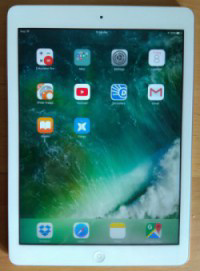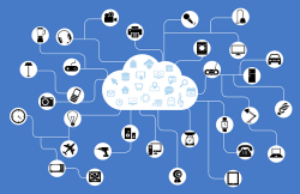2.3: More Computing Devices
( \newcommand{\kernel}{\mathrm{null}\,}\)
Other Computing Devices
A personal computer is designed to be a general-purpose device, able to solve many different types of problems. As the technologies of the personal computer have become more commonplace, many of the components have been integrated into other devices that previously were purely mechanical. The definition or description of what defines a computer has changed. Portability has been an important feature for most users. Here is an overview of some trends in personal computing.
Portable Computers

Portable computing today includes laptops, notebooks and netbooks, many weighing less than 4 pounds and providing longer battery life. The MacBook Air is a good example of this: it weighs less than three pounds and is only 0.68 inches thick!
Netbooks (short for Network Books) are extremely light because they do not have a hard drive, depending instead on the Internet “cloud” for data and application storage. Netbooks depend on a Wi-Fi connection and can run Web browsers as well as a word processor.
Smartphones
While cell phones were introduced in the 1970s, smartphones have only been around for the past 20 years. As cell phones evolved they gained a broader array of features and programs. Today’s smartphones provide the user with telephone, email, location, and calendar services, to name a few. They function as a highly mobile computer, able to connect to the Internet through either cell technology or Wi-Fi. Smartphones have revolutionized computing, bringing the one feature PCs and laptops could not deliver, namely mobility. Consider the following data regarding mobile computing [4]:
- There are 3.7 billion global mobile Internet users as at January 2018.
- Mobile devices influenced sales to the tune of over $1.4 trillion in 2016.
- Mobile commerce revenue in the U.S. is projected to be $459.38 billion in 2018, and it is estimated to be $693.36 billion by 2019.
- By the end of 2018, over $1 trillion — or 75 percent — of ecommerce sales in China will be done via mobile devices.
- The average order value for online orders placed on Smartphones in the first quarter of 2018 is $84.55 while the average order value for orders placed on Tablets is $94.91.
- Of the 2.79 billion active social media users in the world, 2.55 billion actively use their mobile devices for social media-related activities.
- 90 percent of the time spent on mobile devices is spent in apps.
- Mobile traffic is responsible for 52.2 percent of Internet traffic in 2018 — compared to 50.3 percent from 2017.
- While the total percentage of mobile traffic is more than desktop, engagement is higher on desktop. 55.9 percent of time spent on sites is by desktop users and 40.1 percent of time spent on sites is by mobile users.
- By 2020, mobile commerce will account for 45 percent of all e-commerce activities — compared to 20.6 percent in 2016.
The Apple iPhone was introduced in January 2007 and went on the market in June of that same year. Its ease of use and intuitive interface made it an immediate success and solidified the future of smartphones. The first Android phone was released in 2008 with functionality similar to the iPhone.
Tablet Computers

A tablet computer uses a touch screen as its primary input and is small enough and light enough to be easily transported. They generally have no keyboard and are self-contained inside a rectangular case. Apple set the standard for tablet computing with the introduction of the iPad in 2010 using iOS, the operating system of the iPhone. After the success of the iPad, computer manufacturers began to develop new tablets that utilized operating systems that were designed for mobile devices, such as Android.
Global market share for tablets has changed since the early days of Apple’s dominance. Today the iPad has about 25% of the global market while Amazon Fire has 15% and Samsung Galaxy has 14%. [5] However, the popularity of tablets has declined sharply in recent years.
Integrated Computing and Internet of Things (IoT)
Mobile computing is having a huge impact on the business world today. The use of smartphones and tablet computers is rising at double-digit rates each year. The Gartner Group, in a report issued in April, 2013, estimates that over 1.7 million mobile phones will ship in the US in 2013 as compared to just over 340,000 personal computers. Over half of these mobile phones are smartphones.[2] Almost 200,000 tablet computers are predicted to ship in 2013. According to the report, PC shipments will continue to decline as phone and tablet shipments continue to increase. [3]
Along with advances in computers themselves, computing technology is being integrated into many everyday products. From automobiles to refrigerators to airplanes, computing technology is enhancing what these devices can do and is adding capabilities into our every day lives thanks in part to IoT.

Internet of Things and the Cloud
The Internet of Things (IoT) is a network of billions of devices, each with their own unique network address, around the world with embedded electronics allowing them to connect to the Internet for the purpose of collecting and sharing data, all without the involvement of human beings.[6]
Objects ranging from a simple light bulb to a fitness band such as FitBit to a driverless truck are all part of IoT thanks to the processors inside them. A smartphone app can control and/or communicate with each of these devices as well as others such as electric garage door openers (for those who can’t recall if the door has been closed), kitchen appliances (“Buy milk after work today.”), thermostats such as Nest, home security, audio speakers, and the feeding of pets.
Here are three of the latest ways that computing technologies are being integrated into everyday products through IoT:



